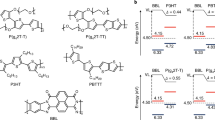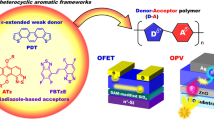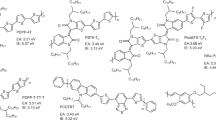Abstract
Widely used solid-state devices fabricated with inorganic semiconductors, including light-emitting diodes and solar cells, derive much of their function from the p–n junction. Such junctions lead to diode characteristics and are attained when p-doped and n-doped materials come into contact with each other. Achieving bilayer p–n junctions with semiconducting polymers has been hindered by difficulties in the deposition of thin films with independent p-doped and n-doped layers1,2. Here we report on how to achieve permanently fixed organic p–n heterojunctions by using a cationic conjugated polyelectrolyte with fluoride counteranions and an underlayer composed of a neutral conjugated polymer bearing anion-trapping functional groups. Application of a bias leads to charge injection and fluoride migration into the neutral layer, where irreversible covalent bond formation takes place. After the initial charging and doping, one obtains devices with no delay in the turn on of light-emitting electrochemical behaviour and excellent current rectification. Such devices highlight how mobile ions in organic media can open opportunities to realize device structures in ways that do not have analogies in the world of silicon and promise new opportunities for integrating organic materials within technologies now dominated by inorganic semiconductors.
This is a preview of subscription content, access via your institution
Access options
Subscribe to this journal
Receive 12 print issues and online access
$259.00 per year
only $21.58 per issue
Buy this article
- Purchase on Springer Link
- Instant access to full article PDF
Prices may be subject to local taxes which are calculated during checkout




Similar content being viewed by others
References
Cheng, C. H. W. & Lonergan, M. C. A conjugated polymer pn junction. J. Am. Chem. Soc. 126, 10536–10537 (2004).
Pfeiffer, M. et al. Doped organic semiconductors: Physics and application in light emitting diodes. Org. Electron. 4, 89–103 (2003).
Pei, Q. B., Yu, G., Zhang, C., Yang, Y. & Heeger, A. J. Polymer light-emitting electrochemical-cells. Science 269, 1086–1088 (1995).
Pachler, P., Wenzl, F. P., Scherf, U. & Leising, G. The efficiency of light-emitting electrochemical cells. J. Phys. Chem. B 109, 6020–6024 (2005).
Kervella, Y., Armand, M. & Stephan, O. Organic light-emitting electrochemical cells based on polyfluorene. Investigation of the failure modes. J. Electrochem. Soc. 148, H155–H160 (2001).
Smith, D. L. Steady state model for polymer light-emitting electrochemical cells. J. Appl. Phys. 81, 2869–2880 (1997).
Matyba, P., Maturova, K., Kemerink, M., Robinson, N. D. & Edman, L. The dynamic organic p–n junction. Nature Mater. 8, 672–676 (2009).
Gao, J., Yu, G. & Heeger, A. J. Polymer light-emitting electrochemical cells with frozen p–i–n junction. Appl. Phys. Lett. 71, 1293–1295 (1997).
Gao, J., Li, Y. F., Yu, G. & Heeger, A. J. Polymer light-emitting electrochemical cells with frozen junctions. J. Appl. Phys. 86, 4594–4599 (1999).
Leger, J. M., Patel, D. G., Rodovsky, D. B. & Bartholomew, G. P. Polymer photovoltaic devices employing a chemically fixed p–i–n junction. Adv. Funct. Mater. 18, 1212–1219 (2008).
Leger, J. M., Rodovsky, D. B. & Bartholomew, G. R. Self-assembled, chemically fixed homojunctions in semiconducting polymers. Adv. Mater. 18, 3130–3134 (2006).
Yamaguchi, S., Shirasaka, T., Akiyama, S. & Tamao, K. Dibenzoborole-containing pi-electron systems: Remarkable fluorescence change based on the ‘on/off’ control of the p(pi)–pi* conjugation. J. Am. Chem. Soc. 124, 8816–8817 (2002).
Kubo, Y. et al. A colorimetric and ratiometric chemosensor with three emission changes: Fluoride ion sensing by a triarylborane–porphyrin conjugate. Angew. Chem. Int. Ed. 42, 2036–2040 (2003).
Garcia, A., Brzezinski, J. Z. & Nguyen, T. Q. Cationic conjugated polyelectrolyte electron injection layers: Effect of halide counterions. J. Phys. Chem. C 113, 2950–2954 (2009).
Steuerman, D. W. et al. Imaging the interfaces of conjugated polymer optoelectronic devices. Adv. Mater. 20, 528–534 (2008).
Hoven, C. V., Garcia, A., Bazan, G. C. & Nguyen, T. Q. Recent applications of conjugated polyelectrolytes in optoelectronic devices. Adv. Mater. 20, 3793–3810 (2008).
Wu, H. B. et al. Efficient electron injection from a bilayer cathode consisting of aluminum and alcohol-/water-soluble conjugated polymers. Adv. Mater. 16, 1826–1830 (2004).
Hoven, C. V. et al. Electron injection into organic semiconductor devices from high work function cathodes. Proc. Natl Acad. Sci. USA 105, 12730–12735 (2008).
Hardy, L. C. & Shriver, D. F. Preparation and electrical response of solid polymer electrolytes with only one mobile species. J. Am. Chem. Soc. 107, 3823–3828 (1985).
Ratner, M. A. & Shriver, D. F. Ion-transport in solvent-free polymers. Chem. Rev. 88, 109–124 (1988).
Zhang, Q. S. et al. Highly efficient electroluminescence from green-light-emitting electrochemical cells based on Cu–I complexes. Adv. Funct. Mater. 16, 1203–1208 (2006).
Hoven, C. et al. Ion motion in conjugated polyelectrolyte electron transporting layers. J. Am. Chem. Soc. 129, 10976–10977 (2007).
Bernards, D. A., Flores-Torres, S., Abruna, H. D. & Malliaras, G. G. Observation of electroluminescence and photovoltaic response in ionic junctions. Science 313, 1416–1419 (2006).
Cheng, C. H. W., Boettcher, S. W., Johnston, D. H. & Lonergan, M. C. Unidirectional current in a polyacetylene hetero-ionic junction. J. Am. Chem. Soc. 126, 8666–8667 (2004).
Acknowledgements
We gratefully acknowledge the National Science Foundation (DMR Program) and the Institute for Multiscale Materials Studies for financial support. We also thank T. Q. Nguyen and D. Smith for helpful discussions.
Author information
Authors and Affiliations
Contributions
C.V.H., M.E. and G.C.B. designed the experiments, analysed the data and wrote the paper. C.V.H and M.E. carried out the experiments. M.E. and G.C.B. designed the polymers. H.W., M.E., L.G. and D.W. synthesized the polymers.
Corresponding author
Ethics declarations
Competing interests
The authors declare no competing financial interests.
Supplementary information
Supplementary Information
Supplementary Information (PDF 537 kb)
Rights and permissions
About this article
Cite this article
Hoven, C., Wang, H., Elbing, M. et al. Chemically fixed p–n heterojunctions for polymer electronics by means of covalent B–F bond formation. Nature Mater 9, 249–252 (2010). https://doi.org/10.1038/nmat2623
Received:
Accepted:
Published:
Issue Date:
DOI: https://doi.org/10.1038/nmat2623
This article is cited by
-
Advance of Mechanically Controllable Break Junction for Molecular Electronics
Topics in Current Chemistry (2017)
-
Light-Emitting Electrochemical Cells: A Review on Recent Progress
Topics in Current Chemistry (2016)



